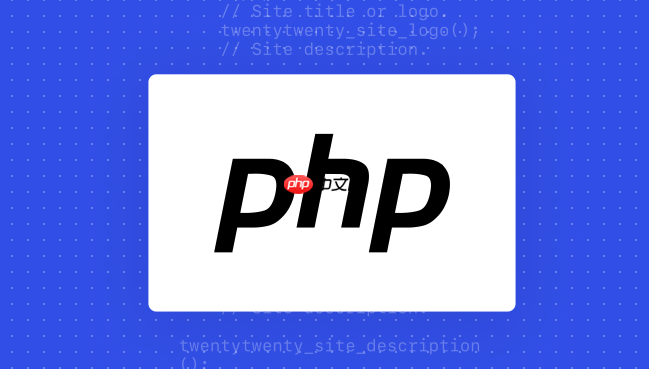使用面向对象方式将数据插入mysql数据库的步骤如下:1. 创建数据库连接类,负责建立和关闭连接;2. 定义数据插入类,使用预处理语句防止sql注入;3. 在插入类中使用try-catch处理异常,提升错误处理能力;4. 使用批量插入方法提高插入性能。通过封装数据库操作,代码结构更清晰、安全性和维护性更高,同时支持多条数据高效插入。

将数据插入到MySQL数据库,用面向对象的方式,其实就是把数据库操作封装成类,让代码更清晰、易维护。核心在于创建一个数据库连接类,然后定义插入方法。

解决方案:

首先,你需要一个数据库连接类,这个类负责建立和关闭数据库连接。
立即学习“PHP免费学习笔记(深入)”;
class Database {
private $host = "localhost";
private $username = "your_username";
private $password = "your_password";
private $database = "your_database";
public $conn;
public function __construct() {
$this->conn = new mysqli($this->host, $this->username, $this->password, $this->database);
if ($this->conn->connect_error) {
die("Connection failed: " . $this->conn->connect_error);
}
}
public function closeConnection() {
$this->conn->close();
}
}接下来,创建一个处理数据插入的类。这个类会使用上面的数据库连接类来执行SQL语句。

class DataInserter {
private $db;
public function __construct(Database $db) {
$this->db = $db;
}
public function insertData($table, $data) {
$columns = implode(", ", array_keys($data));
$values = "";
foreach ($data as $key => $value) {
$values .= "'" . $this->db->conn->real_escape_string($value) . "', ";
}
$values = rtrim($values, ", "); // 去掉末尾的逗号和空格
$sql = "INSERT INTO $table ($columns) VALUES ($values)";
if ($this->db->conn->query($sql) === TRUE) {
return "New record created successfully";
} else {
return "Error: " . $sql . "<br>" . $this->db->conn->error;
}
}
}最后,使用这两个类来插入数据。
$db = new Database();
$inserter = new DataInserter($db);
$table = "users";
$data = array(
"firstname" => "John",
"lastname" => "Doe",
"email" => "john.doe@example.com"
);
$result = $inserter->insertData($table, $data);
echo $result;
$db->closeConnection();SQL注入是数据库操作中一个非常严重的安全问题。上面的代码中使用了$this->db->conn->real_escape_string()函数来转义字符串,这是一个基本的防御措施。更安全的方法是使用预处理语句(Prepared Statements)。预处理语句可以有效地防止SQL注入,因为它将SQL查询的结构和数据分离开来。
class DataInserter {
private $db;
public function __construct(Database $db) {
$this->db = $db;
}
public function insertData($table, $data) {
$columns = implode(", ", array_keys($data));
$placeholders = str_repeat("?, ", count($data) - 1) . "?"; // 生成占位符字符串
$sql = "INSERT INTO $table ($columns) VALUES ($placeholders)";
$stmt = $this->db->conn->prepare($sql);
if (!$stmt) {
return "Error preparing statement: " . $this->db->conn->error;
}
$types = str_repeat("s", count($data)); // 根据数据类型生成类型字符串,这里假设都是字符串
$values = array_values($data);
// 使用反射来调用 bind_param,因为参数数量不固定
$params = array(&$types);
foreach ($values as &$value) {
$params[] = &$value;
}
call_user_func_array(array($stmt, 'bind_param'), $params);
if ($stmt->execute()) {
return "New record created successfully";
} else {
return "Error: " . $stmt->error;
}
$stmt->close();
}
}这段代码使用了预处理语句,其中?是占位符。bind_param函数将数据绑定到占位符上,并且会自动进行转义,防止SQL注入。注意,这里使用了反射来动态调用bind_param,因为参数的数量是不固定的。
在实际开发中,异常处理是必不可少的。它可以帮助你更好地处理错误,并提供更友好的用户体验。
class Database {
// ... (之前的代码)
public function __construct() {
try {
$this->conn = new mysqli($this->host, $this->username, $this->password, $this->database);
if ($this->conn->connect_error) {
throw new Exception("Connection failed: " . $this->conn->connect_error);
}
} catch (Exception $e) {
die("Database connection error: " . $e->getMessage());
}
}
// ... (之前的代码)
}
class DataInserter {
// ... (之前的代码)
public function insertData($table, $data) {
try {
$columns = implode(", ", array_keys($data));
$placeholders = str_repeat("?, ", count($data) - 1) . "?";
$sql = "INSERT INTO $table ($columns) VALUES ($placeholders)";
$stmt = $this->db->conn->prepare($sql);
if (!$stmt) {
throw new Exception("Error preparing statement: " . $this->db->conn->error);
}
$types = str_repeat("s", count($data));
$values = array_values($data);
$params = array(&$types);
foreach ($values as &$value) {
$params[] = &$value;
}
call_user_func_array(array($stmt, 'bind_param'), $params);
if ($stmt->execute()) {
return "New record created successfully";
} else {
throw new Exception("Error executing statement: " . $stmt->error);
}
$stmt->close();
} catch (Exception $e) {
return "Error: " . $e->getMessage();
}
}
}这里使用了try-catch块来捕获异常。如果在数据库连接或数据插入过程中发生错误,就会抛出一个异常,并在catch块中处理。这可以防止程序崩溃,并提供更友好的错误信息。
批量插入数据可以显著提高性能。
class DataInserter {
private $db;
public function __construct(Database $db) {
$this->db = $db;
}
public function insertMultipleData($table, $data) {
$columns = implode(", ", array_keys($data[0])); // 假设所有数据都有相同的列
$values = [];
foreach ($data as $row) {
$rowValues = "";
foreach ($row as $key => $value) {
$rowValues .= "'" . $this->db->conn->real_escape_string($value) . "', ";
}
$rowValues = rtrim($rowValues, ", ");
$values[] = "(" . $rowValues . ")";
}
$valuesString = implode(", ", $values);
$sql = "INSERT INTO $table ($columns) VALUES $valuesString";
if ($this->db->conn->query($sql) === TRUE) {
return count($data) . " records created successfully";
} else {
return "Error: " . $sql . "<br>" . $this->db->conn->error;
}
}
}使用方法:
$db = new Database();
$inserter = new DataInserter($db);
$table = "users";
$data = array(
array("firstname" => "John", "lastname" => "Doe", "email" => "john.doe@example.com"),
array("firstname" => "Jane", "lastname" => "Smith", "email" => "jane.smith@example.com"),
array("firstname" => "Peter", "lastname" => "Jones", "email" => "peter.jones@example.com")
);
$result = $inserter->insertMultipleData($table, $data);
echo $result;
$db->closeConnection();这段代码一次性插入多条数据,而不是逐条插入,可以显著提高性能。但是,要注意SQL语句的长度限制,避免一次性插入过多数据导致SQL语句过长。
以上就是面向对象方式实现PHP MySQL数据插入的详细内容,更多请关注php中文网其它相关文章!

PHP怎么学习?PHP怎么入门?PHP在哪学?PHP怎么学才快?不用担心,这里为大家提供了PHP速学教程(入门到精通),有需要的小伙伴保存下载就能学习啦!

Copyright 2014-2025 https://www.php.cn/ All Rights Reserved | php.cn | 湘ICP备2023035733号